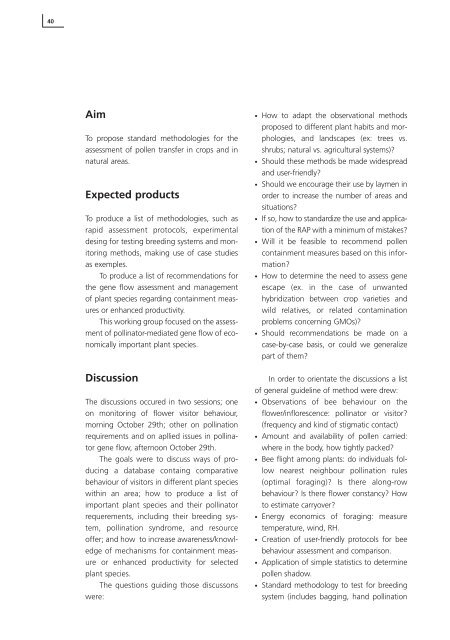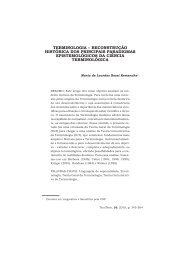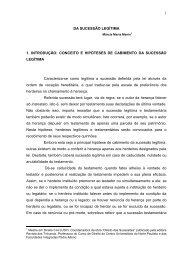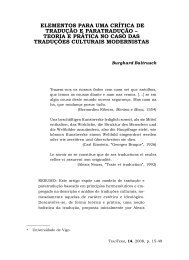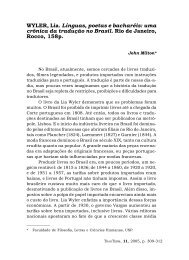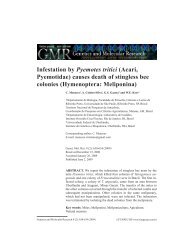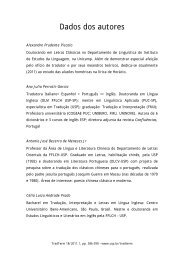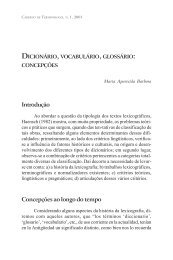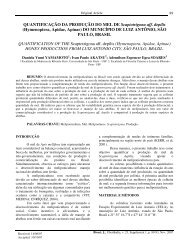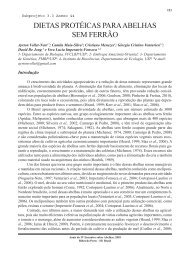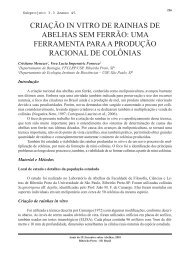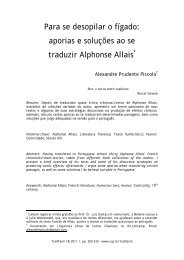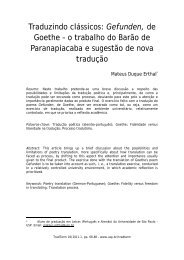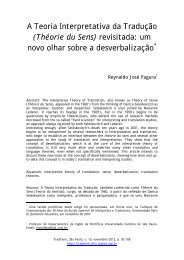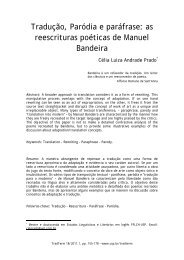Bees as pollinators in Brazil - USP
Bees as pollinators in Brazil - USP
Bees as pollinators in Brazil - USP
Create successful ePaper yourself
Turn your PDF publications into a flip-book with our unique Google optimized e-Paper software.
40<br />
Aim<br />
To propose standard methodologies for the<br />
<strong>as</strong>sessment of pollen transfer <strong>in</strong> crops and <strong>in</strong><br />
natural are<strong>as</strong>.<br />
Expected products<br />
To produce a list of methodologies, such <strong>as</strong><br />
rapid <strong>as</strong>sessment protocols, experimental<br />
des<strong>in</strong>g for test<strong>in</strong>g breed<strong>in</strong>g systems and monitor<strong>in</strong>g<br />
methods, mak<strong>in</strong>g use of c<strong>as</strong>e studies<br />
<strong>as</strong> exemples.<br />
To produce a list of recommendations for<br />
the gene flow <strong>as</strong>sessment and management<br />
of plant species regard<strong>in</strong>g conta<strong>in</strong>ment me<strong>as</strong>ures<br />
or enhanced productivity.<br />
This work<strong>in</strong>g group focused on the <strong>as</strong>sessment<br />
of poll<strong>in</strong>ator-mediated gene flow of economically<br />
important plant species.<br />
Discussion<br />
The discussions occured <strong>in</strong> two sessions; one<br />
on monitor<strong>in</strong>g of flower visitor behaviour,<br />
morn<strong>in</strong>g October 29th; other on poll<strong>in</strong>ation<br />
requirements and on apllied issues <strong>in</strong> poll<strong>in</strong>ator<br />
gene flow, afternoon October 29th.<br />
The goals were to discuss ways of produc<strong>in</strong>g<br />
a datab<strong>as</strong>e conta<strong>in</strong>g comparative<br />
behaviour of visitors <strong>in</strong> different plant species<br />
with<strong>in</strong> an area; how to produce a list of<br />
important plant species and their poll<strong>in</strong>ator<br />
requerements, <strong>in</strong>clud<strong>in</strong>g their breed<strong>in</strong>g system,<br />
poll<strong>in</strong>ation syndrome, and resource<br />
offer; and how to <strong>in</strong>cre<strong>as</strong>e awareness/knowledge<br />
of mechanisms for conta<strong>in</strong>ment me<strong>as</strong>ure<br />
or enhanced productivity for selected<br />
plant species.<br />
The questions guid<strong>in</strong>g those discussons<br />
were:<br />
• How to adapt the observational methods<br />
proposed to different plant habits and morphologies,<br />
and landscapes (ex: trees vs.<br />
shrubs; natural vs. agricultural systems)?<br />
• Should these methods be made widespread<br />
and user-friendly?<br />
• Should we encourage their use by laymen <strong>in</strong><br />
order to <strong>in</strong>cre<strong>as</strong>e the number of are<strong>as</strong> and<br />
situations?<br />
• If so, how to standardize the use and application<br />
of the RAP with a m<strong>in</strong>imum of mistakes?<br />
• Will it be fe<strong>as</strong>ible to recommend pollen<br />
conta<strong>in</strong>ment me<strong>as</strong>ures b<strong>as</strong>ed on this <strong>in</strong>formation?<br />
• How to determ<strong>in</strong>e the need to <strong>as</strong>sess gene<br />
escape (ex. <strong>in</strong> the c<strong>as</strong>e of unwanted<br />
hybridization between crop varieties and<br />
wild relatives, or related contam<strong>in</strong>ation<br />
problems concern<strong>in</strong>g GMOs)?<br />
• Should recommendations be made on a<br />
c<strong>as</strong>e-by-c<strong>as</strong>e b<strong>as</strong>is, or could we generalize<br />
part of them?<br />
In order to orientate the discussions a list<br />
of general guidel<strong>in</strong>e of method were drew:<br />
• Observations of bee behaviour on the<br />
flower/<strong>in</strong>florescence: poll<strong>in</strong>ator or visitor?<br />
(frequency and k<strong>in</strong>d of stigmatic contact)<br />
• Amount and availability of pollen carried:<br />
where <strong>in</strong> the body, how tightly packed?<br />
• Bee flight among plants: do <strong>in</strong>dividuals follow<br />
nearest neighbour poll<strong>in</strong>ation rules<br />
(optimal forag<strong>in</strong>g)? Is there along-row<br />
behaviour? Is there flower constancy? How<br />
to estimate carryover?<br />
• Energy economics of forag<strong>in</strong>g: me<strong>as</strong>ure<br />
temperature, w<strong>in</strong>d, RH.<br />
• Creation of user-friendly protocols for bee<br />
behaviour <strong>as</strong>sessment and comparison.<br />
• Application of simple statistics to determ<strong>in</strong>e<br />
pollen shadow.<br />
• Standard methodology to test for breed<strong>in</strong>g<br />
system (<strong>in</strong>cludes bagg<strong>in</strong>g, hand poll<strong>in</strong>ation


